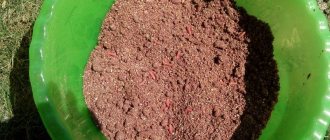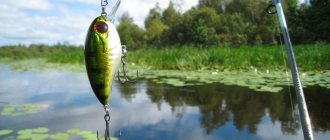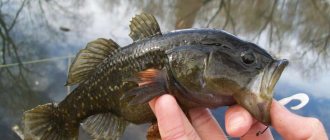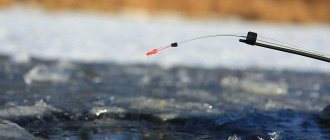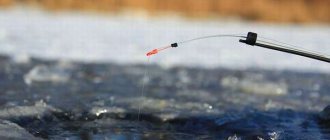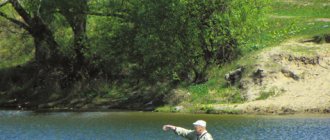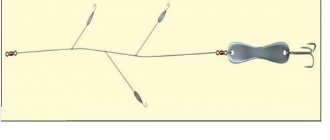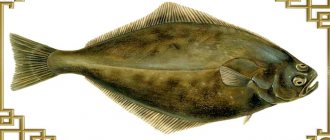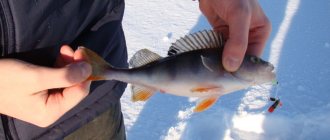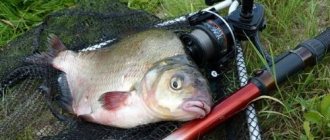Autumn has arrived with corresponding cool weather, and the air temperature during this period drops quite significantly, which is not at all conducive to going out for overnight fishing, or indeed fishing at night. It is true that the water temperature is not decreasing so sharply yet. Taking into account changes in natural factors, the tactics of catching white fish also change.
Catching white fish
White fish fishing spots
First of all, the place where I catch white fish itself changes: from dam and pond fishing I switch to river fishing. On the dam, due to frequent rains and the slippery surface corresponding to wet concrete, which can lead to very unpleasant late-autumn swimming, fishing becomes almost impossible.
The result is a wide strip of wet concrete covered with a thin layer of aquatic vegetation, upon which it is easy to slide straight into icy water - not a pleasant prospect. Therefore, you have to place the rods far from the water's edge (which makes float fishing completely impossible), and tie the cage with ropes to bushes and branches sticking out of the concrete, and taking water from a reservoir to mix bait, even with a special soft bucket on a long line, becomes a very lengthy and completely unattractive procedure. The weather is also not good - wind, waves, heavy fog. The water in the reservoir cools down thoroughly, and the fish rolls down to deeper places, where the water, without being mixed by wind and waves, remains warmer. Due to the above reasons, a trip to dam fishing may turn out to be completely “idle”. So, the dam somehow doesn’t appeal to me as a place for late-autumn fishing for white fish.
On ponds, with the exception of some paid reservoirs, the owners of which took care that their fish were not too diluted with water, the late autumn bite becomes completely unpredictable, and often it does not exist at all. By the way, the problem of paid reservoirs sufficiently saturated with fish is very acute. Okay, the distance from the city itself, okay, a considerable price for fishing, okay, restrictions on the weight and number of caught specimens you can take with you, but at least there was fish there! According to the logic of things, if in good, “cool” weather you catch, say, 20 kg of good fish there (and, of course, you get the required quota), then during the period of no biting on a normal paid site you should catch at least two kilograms, that is, ten times less.
If, during a period of normal, settled weather, a dozen or three or four fishermen sit along the banks of a pond (and not all of them came for their first fishing trip in their lives), and only one catches a couple of fish (albeit good ones) (having thrown such a number into the reservoir expensive bait, which would probably be enough to feed the entire population of fish in the water), then you begin to understand that something is wrong with the reservoir, for which you pay a lot of money to visit, something has been “dirty” there. Either the water was slightly, almost imperceptibly, dumped, or before the weekend, when the largest number of people go fishing, the fish were well fed, making it well-fed and lazy, or there is no normal fish as such in this reservoir. Unfortunately, we have the majority of such paid reservoirs. It’s not that fishermen don’t have the opportunity to bring home several tens of kilograms of fish (and why, in fact, so much, not to carry it to the market), but even to keep a worthy opponent on the gear to their heart’s content and for pleasure.
Catching white fish
White fish on a spoon
Photo of the gate
If the autumn cooling of water bodies goes beyond a certain temperature limit, then a lot begins to change in the behavior of both peaceful and predatory fish. First of all, the attitude towards the type and amount of food consumed becomes different, since the colder the water, the lower the rate of digestion in cold-blooded organisms. However, in this situation, plant food is digested most slowly and food of animal origin is digested quite tolerably.
Of course, in icy water all fish try to move as little as possible and at low speeds, since at low temperatures the flow of energy to the muscles slows down. Therefore, both predators and white fish tend to find and consume live food that is widespread and easily accessible in a particular body of water. For example, while the autumn water is still quite warm, pike can “graze” large fish in order to eat a lot at one time and then digest it quite quickly. But in late autumn, quite often one encounters a situation when the “toothy” one finds itself next to dense schools of apex or fry, which it feeds on only by opening its mouth. And the predator then bites only the smallest imitations on a spinning rod, and a pike pulled out of the water often has small fish skewered in its mouth on its large teeth.
Purely peaceful white fish, such as roach, bream, silver bream and even bleak, when there is a very successful spawning and subsequent large release of fry, can also switch to similar food in the fall, and usually the fry is eaten by the largest fish, which is of particular interest to the spinning fisher , and for the fly fishing enthusiast. All that remains is to find the place where the fish are concentrated, select a working imitation and determine the activity of its behavior in the water so that it resembles the food currently consumed as much as possible.
Naturally, for white fish with its small mouth without teeth, the bait is often needed to be as small and light as possible, and sometimes it is necessary to cast it quite far. Therefore, for such specific fishing, special equipment is required: a light, whip-like, as they say, sending rod, thin and extremely elastic, soft fishing line, a high-speed light-class reel. Typically, such equipment in a spinning rod belongs to the “light” or “ultralight” class gear. It allows you to confidently cast and make a variety of retrieves with baits weighing from 0.5 grams - be it spinners No. 0 or 00, micro-jigs based on various plastic imitations, streamers or wabiki, the smallest wobblers, etc., as well as natural fry, mounted in a special way on a light “bullet” like a jig or fixed on a tackle.
What will ultimately be “caught” from this assortment will be shown by local practice and the preferences of the fish that will have to be caught. For example, sometimes in the autumn, large roach, dace, and bleak often had to be caught in the middle layers of water by slowly moving rotating spinners of the “zero” number with a narrow silver petal, or even “fly spinners”, which have a miniature propeller instead of a petal. But silver bream and bream, not to mention ide, when a dense school of them was discovered, it was better to take it with a bottom step-by-step retrieve on a very small and narrow foam fish or a light streamer. Also, this fish consistently pecked at small, brightly colored twisters on a rig with a long retractable leader.
Rewinding along the bottom for white fish is quite specific - it consists of very short jerks and pulls, when the handle of the spinning reel is literally made a quarter turn. With this technique, the load usually does not even come off the bottom, but is, as it were, dragged along it, creating a cloud of turbidity, which, undoubtedly, to a large extent attracts various fish, since it imitates an organism swarming in the bottom sediments. The fish react to this and, in a general schooling frenzy, often grab or at least try a compact bait on a retractable leader or on a drop-shot rig, when the imitation is placed directly on the main line at a certain distance above the end sinker.
By the way, not always in a rig with the bait removed from the sinker, the latter is any of the usual imitation discussed above. For example, in the days of deep autumn or pre-winter, when bream, silver bream and even large crucian carp showed obvious “attention” to jig baits when catching a predator, constantly “butting” them during a standard step-by-step retrieve, this fish literally swallowed a fairly decent-sized dark-colored double , placed on a cord approximately 30-50 cm above the main bait. To increase the efficiency, it was only necessary to bring the double’s hooks closer with the help of pliers, and in order for the white fish to take more accurately, it was necessary to shorten the “steps” of the wiring as much as possible. But the most interesting thing was that attempts to “improve” fishing by replacing the naked double with a twister or streamer led to a complete cessation of the faithful grip of the bream or silver bream - again just the old “butting”.
Also, sometimes with step-by-step bottom retrieving, white fish in cold water can be quite successfully caught using unique tandems in the form of the main heavy bait with silver elongated jigs or small spinners located above it on short and hard leashes (2-3 cm long). three. Here, from time to time, it is useful to supplement the hooks of pendants with multi-colored cambrics or beads, as well as natural additives - maggots, pieces of worms, bloodworms. In this case, after each “step” it is necessary to pause for a few seconds, keeping the line taut, or instead of a pause, slowly pull along the bottom a distance of a meter or two.
Autumn spinning fishing for various white fish using small-sized jig spinners, where the dimensions of the rounded petal rarely exceed the size of the little fingernail, has become almost a classic. And the layout of the bait itself must meet certain requirements. It is desirable that the head sinker has the shape of a lentil. This improves the dynamic characteristics of the entire assembly as a whole, and also completely eliminates its axial rotation even with very fast wiring. For the same purpose, the fastener in the sinker is installed above its center of gravity. To prevent the tee of the spinner from getting caught up in the fishing line above the sinker during casting, the fastener ring in the sinker is made as short as possible, which allows the freedom of rotation of the spinner in the “hinge” by no more than 180 degrees.
It was most effective to catch large wild carp using a jig-spinner in icy water, but only in those reservoirs where this fish is present in sufficient quantities. On the eve of winter, carp here clearly become ardent predators, which is why they bite much better not on traditional baits, but on fry, even dead ones, or on fish cutting, which makes catching them with a spinning rod promising. The overwhelming number of bites from large carp occurred at the border between deep and shallow water at the moment the bait lifted off the bottom. At first they felt like a soft hook, similar to when a spoon enters dense thickets of aquatic vegetation. This was followed by a rapid throw into the depths - at a distance of up to 30 meters within a few seconds. This is where high-quality gear is needed - a middle-class rod with a parabolic action and a reel with a good friction brake. Then the usual fishing begins “in circles”, moving to that part of the reservoir where there are no thick algae or snags - anything that could interfere with the success of the fight. It happens that in the fall carp “graze” in shallow water. Bites also happen there, but much less frequently.
Anatoly Mailkov October 20, 2014 at 00:00
Groundbait and lures for white fish
With a change in the location of fishing for white fish, both the gear used for fishing changes (I practically abandon the float rod in favor of a feeder rod), as well as the composition of the bait, in particular its density. I leave the skeleton of the bait mixture itself unchanged, namely (in weight parts):
- Bran – 5;
- Breadcrumbs – 2;
- Ground macadamia – 2;
- Ground oatmeal – 2;
- Oatmeal cookies - 0.1;
- Powdered milk -0.2.
Binders:
- Semolina.
Food filler:
- Steamed millet - 0.5-1.
But I add another 1 part by weight of peas soaked in cold water and then cooked with constant slow stirring (so as not to burn). Moreover, in this particular case, it would be better to use chaff as millet. Then I grind the millet and peas separately into a paste in a food processor and put them in plastic bags to add (before soaking it) to the dry bait base mixture at the pond, not forgetting the semolina.
As flavoring agents during mixing, I add coriander, cinnamon, vanilla, fennel, and also some “branded” ones with the smell of spices to the bait mixture. The color of the bait is better natural or slightly darkened. In the late autumn period, it is advisable to add bloodworms to the bait mixture, but at this time you can hardly find them on sale. Therefore, if you manage to get hold of this useful food filler, be sure to use it - the bait will work many times better.
Fishing occurs in a current that is sometimes quite fast, so an overly loose crumbly mixture will be washed out of the feeder too quickly. However, you should not make the bait too sticky; it should still be washed out of the feeder. By the way, taking into account current fishing, at least in the places where I fish, a feeder will need to weigh about forty grams; a less heavy one will be carried by the river current in a less predictable direction. As in earlier periods of fishing, I use feeders with “wings”. The algae have not died off yet, even in fairly deep places, therefore, in order not to get stuck in them when hooking and not to lose the equipment or hooked fish, you need a fairly sharp lifting of the feeder to the surface of the water, which is achieved with the help of “wings”. Due to the presence of algae, which grow especially abundantly in the shallows along the shore, which makes it difficult to land fish, a landing net will need to have a fairly long handle.
The weather during the end of the white fish fishing season, unfortunately, is not pleasing with its consistency. Heavy rain can be followed by glimpses of the sun several times a day. Accordingly, atmospheric pressure jumps sharply. All this together has a very negative effect on the fish bite. Therefore, getting into “cool” weather becomes extremely difficult, unless you go fishing every day, which, unfortunately, is not available to most anglers. Therefore, you need to be mentally prepared for the fact that the catch may be small or practically non-existent - well, these are the realities of late autumn fishing. But on the way to the chosen fishing spot, you can pick up some fresh, beautiful mushrooms along the way, which will somewhat brighten up the negative impressions of the fishing itself.
When fishing for white fish in the river in late autumn, I personally concluded that the best bait would be a dung worm. Peas are practically not popular with fish; mainly, only various small fish are caught with pearl barley and maggots, and even then, it happens that a bunch of maggots on a hook can hang in the water column completely unclaimed by anyone. However, small fish also bite on the worm, and they bite greedily and aggressively, sharply tugging the line and creating sharp jerks in the tip of the feeder rod, but they are not detected very often, often tearing the worm off the hook with one sharp jerk. Therefore, if you do not want to leave the greedy fish teenagers unpunished, you need to put not the whole worm on the hook, but half, or even a third of it. Then there will be a greater chance of high-quality detection of a pecking fish. By the way, at this time the hooks used are quite large, No. 5-7 according to domestic numbering, always very sharp (due to careful biting) made of thin but strong wire.
True, when fishing for white fish with a worm, there is one type of fish that does not have problems with high-quality hooking; they take, as they say, “up to the tonsils,” but this is unlikely to bring pleasure to the angler. These fish are small perches. In late autumn, quite often, almost right under the shore or along the edge of reed thickets, where the water level is often no more than a couple of tens of centimeters, and is also full of various undead algae, from time to time “mini boilers” appear in which teenage perches they eat various small fish - bitterlings, rudds, small bleaks, etc. Such events usually occur in the morning, although, especially in cloudy weather, they can continue throughout the day. These events, frankly speaking, are not conducive to good fishing for decent fish. Firstly, with its “rustling” in the near-surface layer of water, perch usually scares away more “decent” and calm (read: cautious) fish - crucian carp, roach, bream. And, secondly, the striped robber himself often ends up on the hook of an angler hoping to catch something more significant and interesting. Plus, perches swallow the worm greedily, deeply, causing problems with removing them from the hook, and even after the procedure of releasing the hook itself, the damage caused to the fish often turns out to be incompatible with life.
Fishing for silver bream in early spring
Large river whitefish are a worthy competitor for thin winter tackle. And its stable bite is a joy for the fishing soul. Methods of ice fishing for bream, silver bream, blue bream in the pits of large Pripyat oxbow lakes are somewhat different from similar ones somewhere on the Vitebsk lakes. And therefore, it makes sense to talk about the largely unique experience of Mozyryap in catching white fish from ice with a jig in the last days of the passing winter.
The period of outstanding river whitefish biting occurs, as a rule, in the last week or two before the ice finally melts. And during this period there are some incidents. Every year, local EMERCOM officers scare away ice fishing enthusiasts by flying in hovercraft. And how many fishermen manage to “swim” when leaving the ice... But, leaving all their fears at home, the fishermen crawl onto the dark and so treacherous last ice - after all, the laundry is coming!
The best weather for fishing. This very expression to describe ice fishing for white fish in Pripyat is completely inappropriate. The fact is that whitefish, obeying the laws of evolution, constantly migrates along the river. And if a school of fish is discovered, you don’t have to choose the weather. I had the opportunity to catch fish “with shock” both in a thaw with rain, and on a sunny, windless day, and in twenty-degree frost. And it also happened that a fish that was biting well in the morning stopped biting by lunchtime. And this despite the fact that the weather conditions were stable. The flock just left.
Tactics for catching white fish
In order not to waste your time with the rather unpleasant procedure of pulling hooks out of greedy perch mouths and not to kill or maim “striped” ones you don’t need, it is better to remove the gear from the water for the duration of such a “fight”, which usually lasts no more than 10 minutes - and you won’t kill the perches, and you’ll save your nerves. You should do the same thing in the case when small fish you don’t need, such as bleak and small rudd, start landing on the hook over and over again. This happens when schools of small fish approach the fishing spot, tempted by your groundbait. You just need to take the gear out of the water for 10-15 minutes, and during this time do not feed. Disappointed in your hopes of enjoying yourself “for free”, the little things you don’t need will go away.
It is advisable to re-cast the feeder equipment quite often, thereby feeding your favorite fishing point (you should, of course, cast to the same point). Frequent re-casts will not frighten the fish, but will only attract them with additional feeding of the bait mixture. You should reduce the number of recasts only when you find out that a fairly large and cautious fish has approached the baited place - then you will only need to wait for it to be tempted by your bait, without performing frequent recasts. Having caught one specimen, you need to throw the equipment into the fishing spot and again wait for a bite - in late autumn, as a rule, quite large bream and bream move in schools, which makes it possible to catch several specimens one after another. True, luring a good flock is quite rare. Much more often, unfortunately, roaches (even of good size) or medium-sized white bream and silver bream end up on the hook.
And don’t let the unpredictable bite or changeable weather scare you. Having gone fishing on a non-rainy day (or even during a light autumn rain) and sitting on the river bank with a feeder rod, you will breathe in fresh, already “frozen” air, and you will still enjoy the trip to the bosom of nature.
DIY fishing tackle
Fishing is a real art. It is impossible to comprehend all its nuances even with many years of experience. Our advice to fishermen is just another step on a long and difficult road to perfection, another opportunity to show off to your friends an extraordinary catch, another morning dawn spent on the banks of a river or lake.
Here we have diligently collected as much useful information as possible for all fishing enthusiasts. Advice to fishermen on rigging, equipment, various fishing methods, how to properly make fishing gear with your own hands, as well as which fishing bait is suitable for specific fish - all this will be very useful for both a green beginner and a seasoned bison .
Those who prefer to relax on a river or lake with the whole family will find tips on introducing the younger generation to the mysteries of fishing, and at the same time learn how to make the process exciting, interesting and as comfortable as possible. We also have tips for fishermen regarding the peculiarities of catching different types of fish:
Catfishing is one of the most exciting types of fishing. Catfish always impress with their impressive size, especially when they “sit” on your hook. It’s a pleasure to catch such fish, but to do this you need to know what kind of bait is suitable for fishing, how to set the right fishing spot, etc. All this is on our website in the Catfishing section.
As for the section Fishing for pike perch, you can find advice there on choosing gear and fishing period, features of fishing for pike perch in winter and much more. So catching pike perch will become interesting and definitely productive for you.
Well, if you are planning to go fishing for perch, then take a look at the Perch Fishing section. There you will find a lot of useful information for yourself, namely how to find the “bread” habitat of perch, how to properly hook this predator, how to improve the game of bait to attract large specimens. Those. everything you need to make perch fishing successful for you.
The section Making baits describes many tips and secrets on how to make fishing tackle with your own hands, how to make them better and more effective.
In short, no one can escape your hook. Well, those who like a thorough approach to business can look through special literature on fishing.
If at the moment you don’t want to study, but just relax, in addition to advice for fishermen, we offer you exciting fishing simulators that will help brighten up the anticipation of your next trip.
Welcome to everyone who loves fishing as much as we do!
